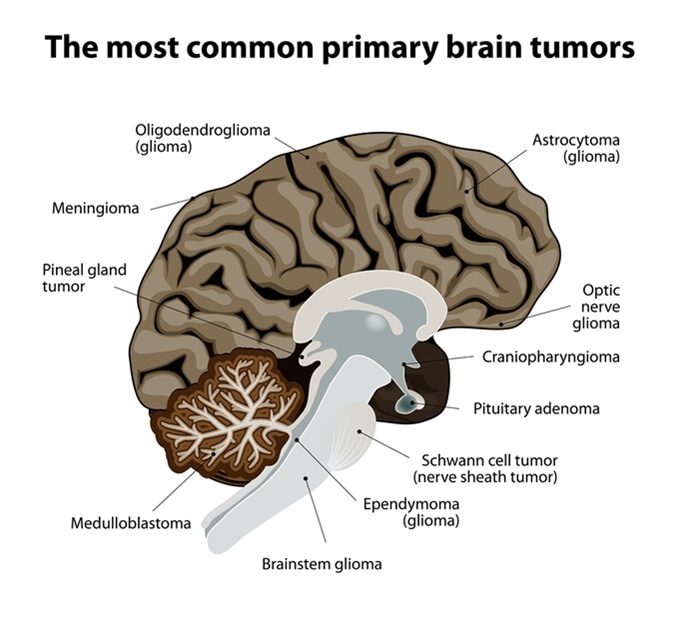Medulloblastomas are tumors arising from embryonal cells in the brain, and occur in various histologic as well as molecular subtypes. In 8 out of 10 children, these tumors arise in the posterior fossa region near the fourth ventricle. However, sonic hedgehog (SHH) tumors arise more often in the lateral hemispheres of the cerebellum, away from the midline.
In tumors that arise in the midline, the tumors cause blockage of the circulation of cerebrospinal fluid (CSF), the fluid secreted by the choroid plexuses in the lateral ventricles of the brain. This fluid normally circulates and nourishes the brain, as well as protecting it against concussive trauma and cushioning it against jolts. When the tumor blocks any of the routes through which the fluid circulates, it builds up and exerts pressure on the brain tissue around it, a condition called hydrocephalus. The symptoms usually present abruptly, and may occur over 2-3 months before the condition is diagnosed.

Common primary brain tumors. Image Credit: Designua / Shutterstock
Symptoms
Typical symptoms due to hydrocephalus include:
- The sudden onset of headaches, which usually occur in the morning, as soon as the patient wakes
- Nausea with forceful or projectile vomiting which is usually not preceded by any gastric upset and is the most common sign of increased intracranial pressure
- Lethargy
- Ataxia or incoordination of gait, and inability to hold the trunk steady during movement or at rest
- Nystagmus or involuntary oscillation of the eyeballs
- Papilledema or swelling of the optic disc, the place where the optic nerve pierces the retinal layers on its passage to the brain, and bulges when the pressure within the brain goes up
Lateral SHH medulloblastomas
The more typical lateral location of SHH medulloblastomas means that appendicular ataxia occurs more commonly than truncal ataxia in these patients. It is possible to localize the side of the tumor because the ataxia occurs on the same side as the tumor. This is manifested as:
- Dysmetria or lack of coordination of voluntary movements like pointing in a specific direction, marked by overshooting or undershooting of the intended destination
- Problems with handwriting
- Gradual inability to keep up with school work
- Unsteadiness of movement which may appear as unusual and recent-onset clumsiness
- Weakness of the abducent and facial nerve, leading to twisting of the face and the appearance of a squint, on the same side as the tumor
- Diplopia or double vision
- Tilting of the head towards one side
- Mild neck stiffness
- Changes in the patient’s personality and behavior
Signs of central CSF blockage appear later as the tumor becomes larger and obstructs the communication between the fourth ventricle and the rest of the central nervous system
As the tumor spreads downwards into the spinal cord, the patient may develop back pain, find it difficult to walk, and may become incontinent for both urine and stool.
Another mode of presentation is the catastrophic onset of unconsciousness and weakness due to bleeding into the tumor.
Infants
In infants, medulloblastomas may present as:
- Weakness without obvious cause
- Slowing of motor and intellectual development
- Losing already acquired developmental milestones
- Feeding problems such as intermittent vomiting
- Failure to gain weight normally
- Enlargement of the head
- Abnormal bulging of the anterior fontanel because of the increased pressure within the brain
- Abnormal eye movements such as the setting sun sign (downward deviation of the eyes) because the ability to look up is lost as the increased pressure compresses the midbrain and consequently some nerves which stimulate the muscles of the eye
Further Reading